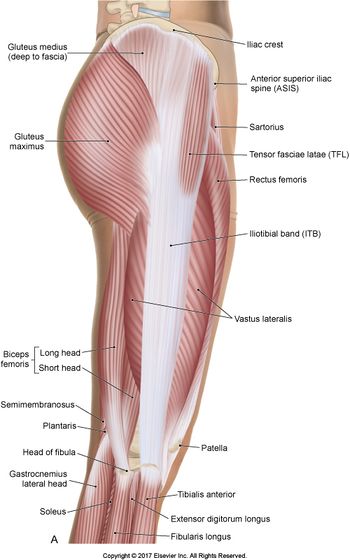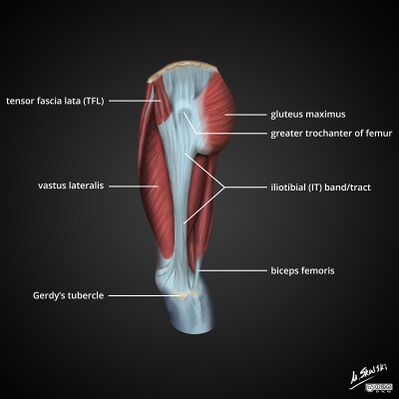Iliotibial Tract: Difference between revisions
No edit summary |
No edit summary |
||
| Line 9: | Line 9: | ||
* There are multiple clinical conditions that can present secondary to a spectrum of ITB dysfunction eg [[Snapping Hip Syndrome|external snapping hip syndrome]], [[Iliotibial Band Syndrome|ITB syndrome]]<ref name=":1">Hyland S, Graefe S, Varacallo M. [https://www.ncbi.nlm.nih.gov/books/NBK537097/ Anatomy, bony pelvis and lower limb, iliotibial band (tract).] StatPearls [Internet]. 2020 Aug 10.Available: https://www.ncbi.nlm.nih.gov/books/NBK537097/<nowiki/>(accessed 27.12.2021)</ref>. | * There are multiple clinical conditions that can present secondary to a spectrum of ITB dysfunction eg [[Snapping Hip Syndrome|external snapping hip syndrome]], [[Iliotibial Band Syndrome|ITB syndrome]]<ref name=":1">Hyland S, Graefe S, Varacallo M. [https://www.ncbi.nlm.nih.gov/books/NBK537097/ Anatomy, bony pelvis and lower limb, iliotibial band (tract).] StatPearls [Internet]. 2020 Aug 10.Available: https://www.ncbi.nlm.nih.gov/books/NBK537097/<nowiki/>(accessed 27.12.2021)</ref>. | ||
Image 1: The iliotibial band (ITB) is a thick band of fascia formed proximally at the hip by the fascia of the gluteus maximus, gluteus medius and tensor fasciae latae muscles. | Image 1: The iliotibial band (ITB). is a thick band of fascia formed proximally at the hip by the fascia of the gluteus maximus, gluteus medius and tensor fasciae latae muscles. | ||
# Due to the ITBand’s insertion on Gerdy’s tubercle, it actually has no bony attachment along the femur. Therefore, it has the tendency to shift anterior/posterior (front to back) as your knee flexes and extends. | # Due to the ITBand’s insertion on Gerdy’s tubercle, it actually has no bony attachment along the femur. Therefore, it has the tendency to shift anterior/posterior (front to back) as your knee flexes and extends. | ||
| Line 17: | Line 17: | ||
The iliotibial band (ITB) is a thick band of fascia formed proximally at the hip by the fascia of the gluteus maximus, gluteus medius and tensor fasciae latae muscles. | The iliotibial band (ITB) is a thick band of fascia formed proximally at the hip by the fascia of the gluteus maximus, gluteus medius and tensor fasciae latae muscles. | ||
The band consists of deep and superficial layers: | The band consists of deep and superficial layers insertions are: | ||
# The superficial layer is the main tendinous component and inserts onto Gerdy's tubercle on the anterior lateral tibia | # The superficial layer is the main tendinous component and inserts onto Gerdy's tubercle on the anterior lateral tibia | ||
Revision as of 12:37, 27 December 2021
Top Contributors - Eman Ammar and Lucinda hampton
Description[edit | edit source]
The iliotibial band (ITB) is a thick band of fascia formed proximally at the hip by the fascia of the gluteus maximus, gluteus medius and tensor fasciae latae muscles[1].
- The ITB runs along the lateral thigh and serves as an important structure involved in lower extremity motion.
- There are multiple clinical conditions that can present secondary to a spectrum of ITB dysfunction eg external snapping hip syndrome, ITB syndrome[2].
Image 1: The iliotibial band (ITB). is a thick band of fascia formed proximally at the hip by the fascia of the gluteus maximus, gluteus medius and tensor fasciae latae muscles.
- Due to the ITBand’s insertion on Gerdy’s tubercle, it actually has no bony attachment along the femur. Therefore, it has the tendency to shift anterior/posterior (front to back) as your knee flexes and extends.
- The Iliotibial Band is made up of mostly collagen fibers. Collagen is a protein, the strongest protein found in nature. The collagen fibres are aligned in a very organized, vertical fashion as this allows for better force absorption with weight bearing activities. There is a small amount of elastin fibers amongst the layers of collagen, which allow it to be slightly elastic and pliable helping it act as a spring. However, this does not give it the ability to “stretch” or “change length” like a muscle[3].
Anatomy[edit | edit source]
The iliotibial band (ITB) is a thick band of fascia formed proximally at the hip by the fascia of the gluteus maximus, gluteus medius and tensor fasciae latae muscles.
The band consists of deep and superficial layers insertions are:
- The superficial layer is the main tendinous component and inserts onto Gerdy's tubercle on the anterior lateral tibia
- The deep layer inserts on the intermuscular septum of the distal femur
A small recess exists between the lateral femoral epicondyle and the ITB, which contains a synovial extension of the knee joint capsule (lateral synovial recess)[1]
The ITB shares the innervation of the TFL and gluteus maximus via the superior gluteal nerve and inferior gluteal nerve
Function.[edit | edit source]
Proximal ITB function includes:
- Hip extension
- Hip abduction
- Lateral hip rotation
Distally, ITB function depends on the position of the knee joint
- Full extension to 20 to 30 degrees of flexion: Active knee extensor, ITB lying anterior to the lateral femoral epicondyle
- 20 to 30 degrees of flexion to full flexion ROM: Active knee flexor, ITB lies posterior relative to the lateral femoral epicondyle[2]
Physiotherapy[edit | edit source]
The iliotibial band is one of the most common running injuries we see as physiotherapists. It is considered a non-traumatic overuse injury and is often concomitant with underlying weakness of hip abductor muscles. For more see Iliotibial Band Syndrome. Clinical examination testing for ITB dysfunction is best elicited utilizing the Ober Test, see here
External snapping hip syndrome is another ITB pathology you may encounter[4]. Snapping Hip Syndrome is a condition that is characterized by a snapping sensation, and/or audible “snap” or “click” noise, in or around the hip when it is in motion.
References[edit | edit source]
- ↑ 1.0 1.1 Radiopedia ITB Available: https://radiopaedia.org/articles/iliotibial-band?lang=gb (accessed 27.12.2021)
- ↑ 2.0 2.1 Hyland S, Graefe S, Varacallo M. Anatomy, bony pelvis and lower limb, iliotibial band (tract). StatPearls [Internet]. 2020 Aug 10.Available: https://www.ncbi.nlm.nih.gov/books/NBK537097/(accessed 27.12.2021)
- ↑ Boulder sports Physio Iliotibial Band (ITBand) Syndrome Available:https://www.bouldersportsphysio.com/blog/blog-post-title-two-5k22t (accessed 27.12.2021)
- ↑ Winston P, Awan R, Cassidy JD, et al. Clinical examination and ultrasound of self-reported snapping hip syndrome in elite ballet dancers. Am J Sports Med. 2007 Jan;35(1):118–126. [PubMed]








